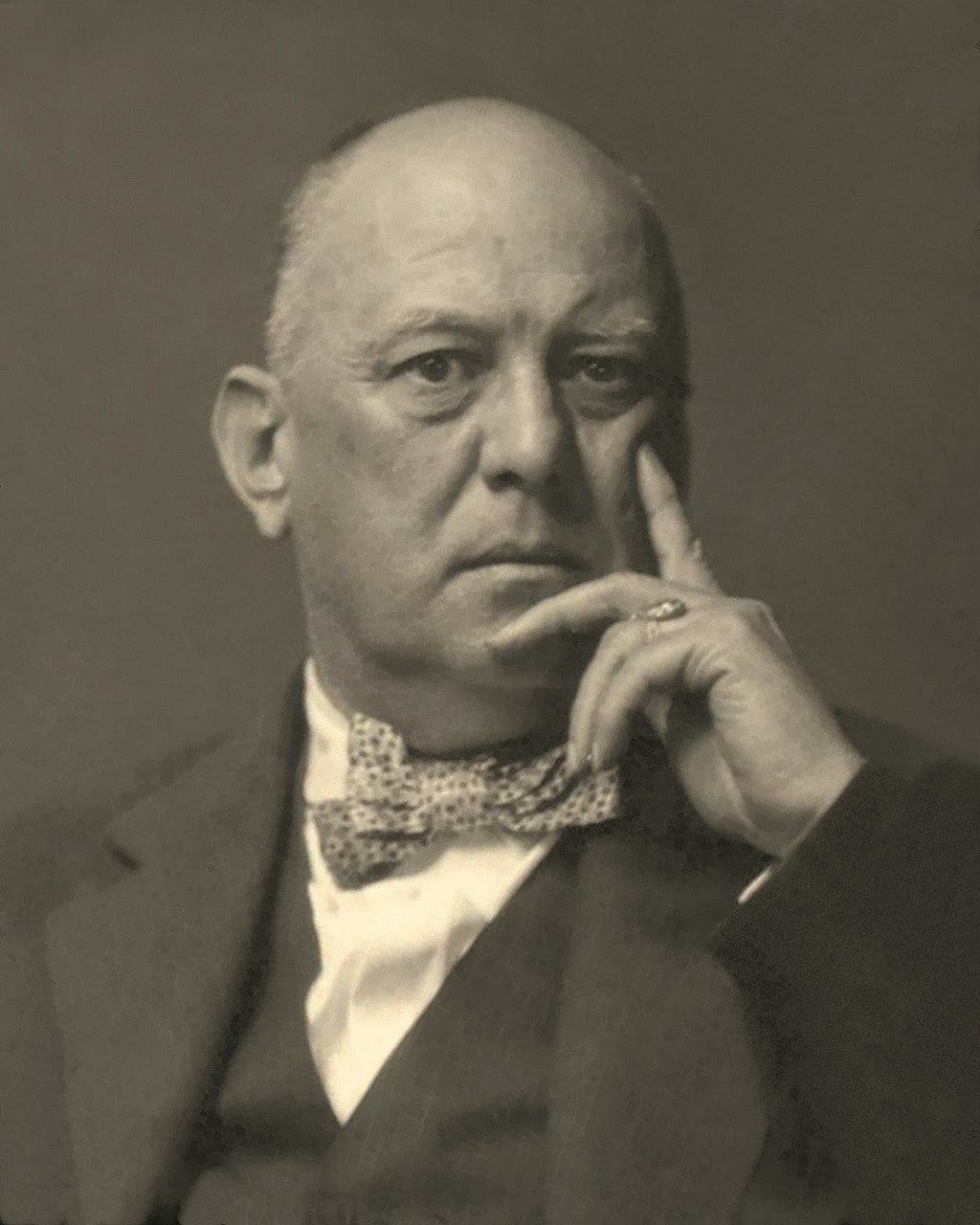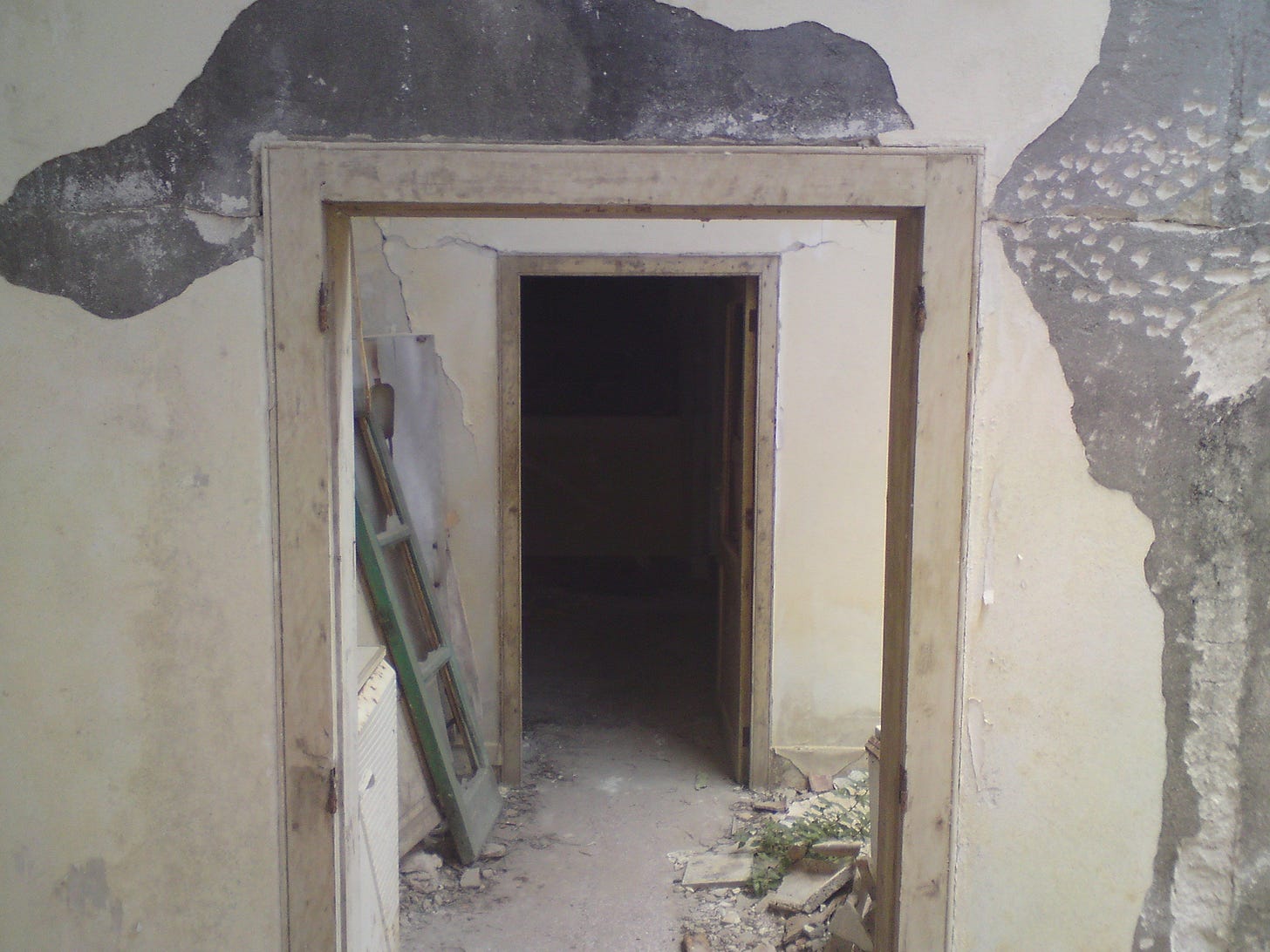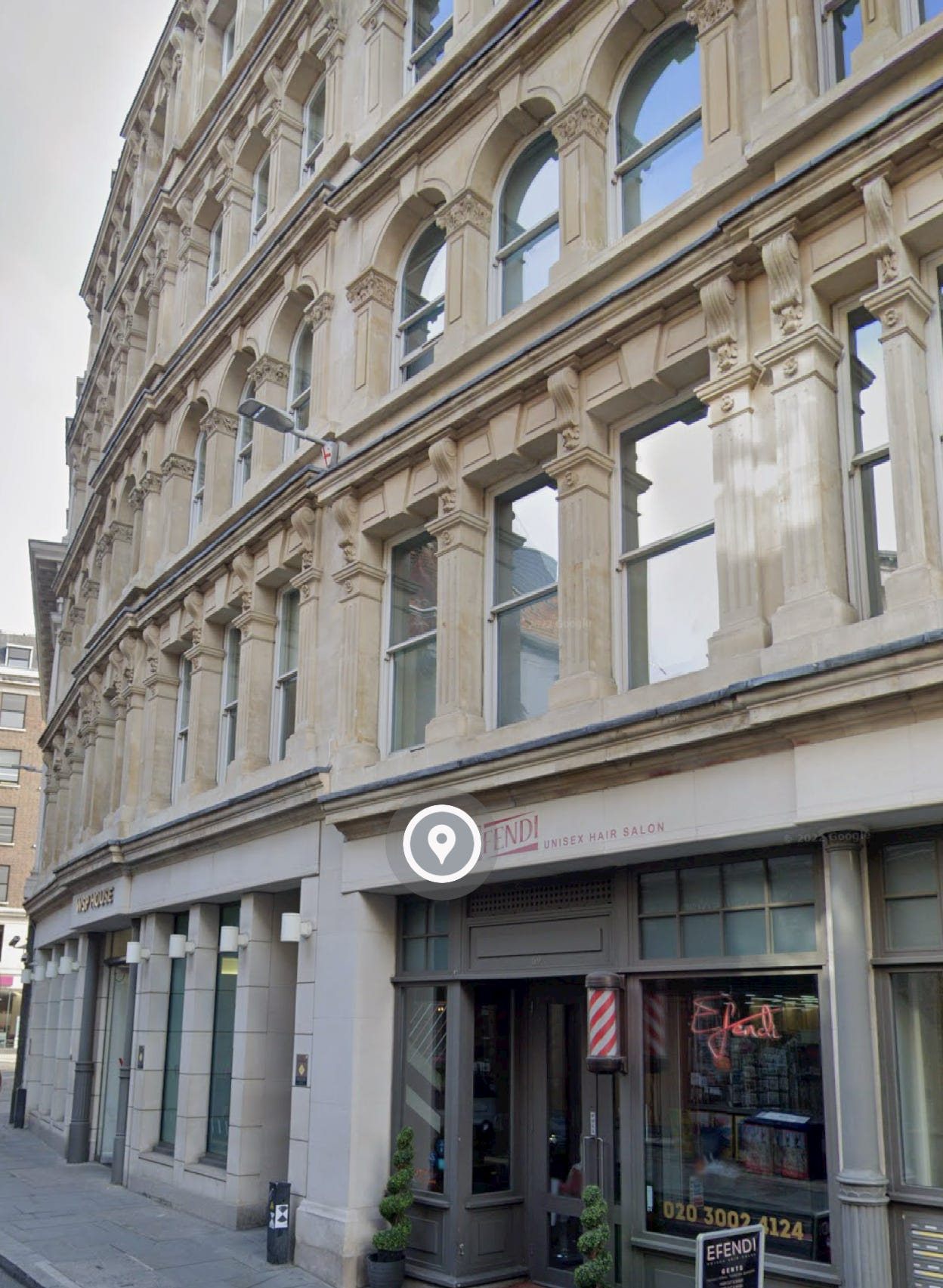Nothing to do with Crowley, just a fake spooky Victorian photo, that I made with AI
A few years ago I noticed that a Victorian apartment block was being vigorously redeveloped, on Chancery Lane, off Fleet Street. As an amateur scholar of all things associated with the strange, mystico-masonic, late 19th/early 20th century cult known as the Golden Dawn, especially its most notorious member, “black magician”, drug addict and self-confessed orgiast Aleister Crowley, I realised the importance of this place. It was Crowley’s infamous home at a crucial stage in his life. So I went to have a look, along with a friend, the poet Tim Cumming.
Here is what we found. It is probably luxe flats for Chinese students now.
Visiting Satan’s Basement
It looks like an ordinary, down-at-heel Victorian apartment block: just a curve of yellowing bricks, dusty shop-windows, and crumbling ornamental stonework. The sense of drabness is underlined by the builders' scaffolding and plastic drapes - as this corner of old London is redeveloped.
But, appearances can be deceptive. This building, number 67 Chancery Lane, was once truly remarkable: a byword for sex, drugs and Satanism. Because this was once the home of Aleister Crowley, the 'wickedest man in the world'.
Crowley was born in 1875, in Leamington Spa; bright and articulate, he was the son of violently evangelical parents; perhaps it was this upbringing which turned him onto the Dark Arts. By the age of 20 he'd left Cambridge University, climbed some mountains, written some poetry - and joined a secret order, the Golden Dawn, a society of posh bohemian occultists which boasted Irish poet W.B.Yeats and Oscar Wilde's sister in its ranks.
Crowley in his later years; image from Wiki (public domain)
The Golden Dawn was known for its rigorous induction process. Hours of ritual, days of prayer, and weeks of study - of ancient magical lore - were required for promotion to higher levels. Crowley proved an able student, and shot up through these hierarchies; as he progressed, Crowley became impatient with the fusty, scholastic attitude of the other Dawn members
At this point he met a fellow occultist called Alan Bennett; Bennett invited Crowley to move in to his flat at 67 Chancery Lane. There, the two likeminded magicians got up to some very strange stuff.
Crowley installed two temples, dedicated to the dark gods and goddesses. In one corner of the apartment Crowley kept a skeleton in a wardrobe, which he fed on small songbirds and cups of blood. Visitors to the flat reported, perhaps unsurprisingly, 'an intense atmosphere of evil' as the two young men conjured hundreds of demons, sometimes in an opiated haze (Crowley was one of the world's first heroin addicts). Those visitors that didn't instantly flee were sometimes invited to participate in the Black Mass, or obscene acts of 'sex magick'.
Crowley and Bennett soon moved out of Chancery Lane, yet the 'evil atmosphere' lingered on, long after their departure. The records show that the landlords had trouble letting the place for a decade.
And now? In a few weeks’ time the interior of the building will be gutted, as it is turned into upmarket flats and offices. So this is the last chance to view the 'wickedest flat in London' - largely as it was. That's if you can persuade the builders to let you in.
And thus, one rainy autumn afternoon, we head down to this oddly neglected snicket of ancient London, where medieval churches line ancient lanes alongside large finance houses and advertising agencies - and we march up to the front door. The site manager, in his hi-viz and helmet, is clearly a busy man, and he is bemused - and largely unininterested - in our quest (he has no idea about Crowley, the Dawn, any of it, and has no time for a history lesson). But he is also amiable, sees no harm in allowing us to peek about. He presumably thinks we are historians of Victorian architecture, and so he lets us in - to have a mooch.
Unfortunately, none of the photos Tim and I took that day have survived; that said, they weren’t especially interesting anyway. No ghosts on the landing. Sorry. However here is a photo of a hallway in Crowley’s notorious and tumbledown “Abbey of Thelema”, in Cefalu Sicily, where he did truly appalling things. I had to break in to this place, I have never forgotten the intensity of what I found and felt there. I will tell this other story some other time on In Search of the OMG.
Tim and I are given free rein to go where we like, by the bored builders, But in truth, there isn't that much to see: some Victorian fireplaces, a couple of dingy corridors, and a scuffed and venerable bathtub. We spend at least an hour trying to find the room where Crowley must have kept the wardrobe with the bird-eating skeletons, or the corner where he placed the infamous little shrine with the “blackamoor” figure - an artefact which apparently oozed a sense of demonic menace.
We find nothing that could be called evidence. And yet the place does have a strange ambience: a pungent air of sickliness, or worse. But that could just be the rotting 70s plasterboard. With the afternoon darkening, and the shadows deepening, we decide to call it a day. It’s been interesting - but not exactly Satanic.
But as we exit, something truly odd happens. As we have established, the builders themselves are blithely unaware of the occult and esoteric history of the place. However, while we are getting ready to leave the site-manager, with a spare few moments, finally takes an actual interest in our visit. “What are you guys doing here”, he says, “It’s just another fading old block of flats, it’s not the Tower of London. What are you looking for?”
So we tell him. We tell him the true story of Aleister Crowley and his songbird-eating skeleton, and the shrine that oozed evil, and as we do his face turns a profound shade of white. He looks intensely shocked.
'That's…. very weird.' he says. 'When we first moved here we found a human skull next to a five pointed star, made of sticks - just sitting on the basement floor. It totally freaked us out. I thought it was someone playing a joke, but it preyed on me for days.'
A joke by some Crowleyans? If so, it is a joke that Aleister Crowley would have adored.
Four other pivotal Golden Dawn sites in London
Mark Mason's Hall, Great Queen Street, WC2
Before the Golden Dawn had their own premises, they used to meet in some chambers in the basement of this freemasons' hall. The dubious occultists were asked to come and go by the back door, so they wouldn't embarrass anyone. Long demolished.
17 Fitzroy Street, W1
This was the first proper temple of the 'Hermetic Order of the Golden Dawn': the rented building was dedicated to Isis-Urania on the 1st March 1888. W.B.Yeats was probably inducted into the Order here in the early 1890s. Destroyed in the Blitz.
Clipstone Street, W1
In 1892 the Order moved to this little thoroughfare running east from Great Portland St. According to historian Ellic Howe, the Dawn paid 10 shillings for two rooms, and their neighbours were “a hairdresser, dairyman, confectioner, two sculptors, cabinet-makers, french polishers, a piano tuner, and the offices of the German Waiters’ Society". Recently demolished.
36 Blythe Road, W6
The last notable address of the Golden Dawn, Blythe Road saw a famous magical battle between Aleister Crowley and W.B.Yeats. It was April 19, 1900, when Crowley, dressed in a kilt, daggar and 'black mask of Osiris', tried to take control of the Order's vaults, protected in the Blythe Road temple. With the help of a bemused constable, Yeats managed to rebuff the spell-casting Crowley; the shattered Order was extinguished soon after. Blythe Road is the only major Golden Dawn site still standing in London, and thus a crucial address in the global history of 'New Age' religions. It should be preserved.
67 Chancery Lane now, about as nondescript as it gets (via Google Maps). Though you can still see the Victorian bones of the building. Ahem








Great piece.
Great read. When can we expect the spooky installment on the Abbey of Thelema?